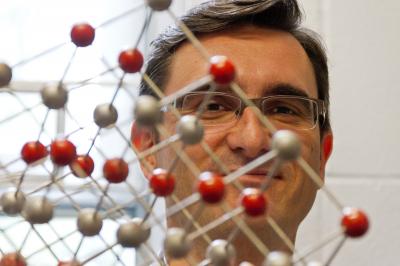May 20 2013
One of the basic principles of nanotechnology is that when you make things extremely small—one nanometer is about five atoms wide, 100,000 times smaller than the diameter of a human hair—they are going to become more perfect.
 Frederic Sansoz, a professor of engineering at the University of Vermont, works at the intersection of nanotechnology and materials science. His work makes extensive use of state-of-the-art atomistic simulation techniques, as well as of atomic force microscopy-based experiments for the discovery of new properties -- like a newly discovered set of defects in coherent twin boundaries. Credit: Joshua Brown, University of Vermont, 2013
Frederic Sansoz, a professor of engineering at the University of Vermont, works at the intersection of nanotechnology and materials science. His work makes extensive use of state-of-the-art atomistic simulation techniques, as well as of atomic force microscopy-based experiments for the discovery of new properties -- like a newly discovered set of defects in coherent twin boundaries. Credit: Joshua Brown, University of Vermont, 2013
"Perfect in the sense that their arrangement of atoms in the real world will become more like an idealized model," says University of Vermont engineer Frederic Sansoz, "with smaller crystals—in for example, gold or copper—it's easier to have fewer defects in them."
And eliminating the defects at the interface separating two crystals, or grains, has been shown by nanotechnology experts to be a powerful strategy for making materials stronger, more easily molded, and less electrically resistant—or a host of other qualities sought by designers and manufacturers.
Since 2004, when a seminal paper came out in Science, materials scientists have been excited about one special of arrangement of atoms in metals and other materials called a "coherent twin boundary" or CTB.
Based on theory and experiment, these coherent twin boundaries are often described as "perfect," appearing like a perfectly flat, one-atom-thick plane in computer models and electron microscope images.
Over the last decade, a body of literature has shown these coherent twin boundaries—found at the nanoscale within the crystalline structure of common metals like gold, silver and copper—are highly effective at making materials much stronger while maintaining their ability to undergo permanent change in shape without breaking and still allowing easy transmission of electrons—an important fact for computer manufacturing and other electronics applications.
But new research now shows that coherent twin boundaries are not so perfect after all.
A team of scientists, including Sansoz, a professor in UVM's College of Engineering and Mathematical Sciences, and colleagues from the Lawrence Livermore National Laboratory and elsewhere, write in the May 19 edition of Nature Materials that coherent twin boundaries found in copper "are inherently defective."
With a high-resolution electron microscope, using a more powerful technique than has ever been used to examine these boundaries, they found tiny kink-like steps and curvatures in what had previously been observed as perfect.
Even more surprising, these kinks and other defects appear to be the cause of the coherent twin boundary's strength and other desirable qualities.
"Everything we have learned on these materials in the past 10 years will have to be revisited with this new information," Sansoz says
The experiment, led by Morris Wang at the Lawrence Livermore Lab, applied a newly developed mapping technique to study the crystal orientation of CTBs in so-called nanotwinned copper and "boom—it revealed these defects," says Sansoz.
This real-world discovery conformed to earlier intriguing theoretical findings that Sansoz had been making with "atomistic simulations" on a computer. The lab results sent Sansoz back to his computer models where he introduced the newly discovered "kink" defects into his calculations. Using UVM's Vermont Advanced Computing Center, he theoretically confirmed that the kink defects observed by the Livermore team lead to "rather rich deformation processes at the atomic scale," he says, that do not exist with perfect twin boundaries.
With the computer model, "we found a series of completely new mechanisms," he says, for explaining why coherent twin boundaries simultaneously add strength and yet also allow stretching (what scientists call "tensile ductility")— properties that are usually mutually exclusive in conventional materials.
"We had no idea such defects existed," says Sansoz. "So much for the perfect twin boundary. We now call them defective twin boundaries."
For several decades, scientists have looked for ways to shrink the size of individual crystalline grains within metals and other materials. Like a series of dykes or walls within the larger structure, the boundaries between grains can slow internal slip and help resist failure. Generally, the more of these boundaries—the stronger the material.
Originally, scientists believed that coherent twin boundaries in materials were much more reliable and stable than conventional grain boundaries, which are incoherently full of defects. But the new research shows they could both contain similar types of defects despite very different boundary energies.
"Understanding these defective structures is the first step to take full use of these CTBs for strengthening and maintaining the ductility and electrical conductivity of many materials," Morris Wang said. "To understand the behavior and mechanisms of these defects will help our engineering design of these materials for high-strength applications."
For Sansoz, this discovery underlines a deep principle, "There are all manner of defects in nature," he says, "with nanotech, you are trying to control the way they are formed and dispersed in matter, and to understand their impact on properties. The point of this paper is that some defects make a material stronger."